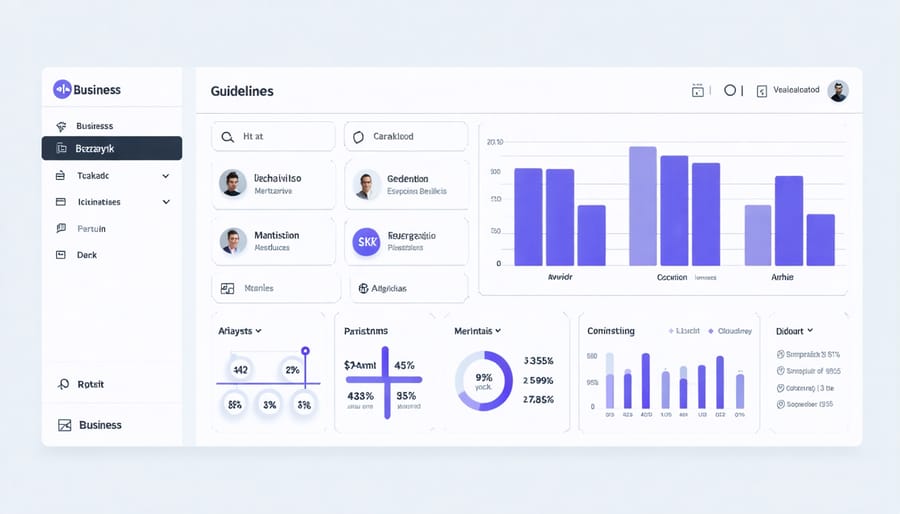Transform raw data into actionable insights by embracing data-driven strategies across your organization. Canadian businesses leveraging analytics outperform competitors by 2.3x in revenue growth, yet 67% of companies struggle to implement effective data practices.
Success in today’s digital economy demands more than gut feelings and traditional market wisdom. From Toronto’s thriving tech corridor to Vancouver’s innovation hub, leading Canadian enterprises harness data to predict market trends, optimize operations, and deliver personalized customer experiences with unprecedented precision.
The stakes are clear: Organizations that master data-driven decision-making capture market share, reduce operational costs by up to 25%, and build resilient business models that weather economic uncertainty. By combining advanced analytics with Canadian business acumen, companies gain the competitive edge needed to thrive in both domestic and global markets.
This comprehensive guide reveals proven frameworks for embedding data intelligence into your business DNA, ensuring compliance with Canadian privacy regulations while maximizing the value of your information assets. Whether you’re a startup founder or an established enterprise leader, these strategies will accelerate your journey toward data-driven excellence.
The Foundation of Data-Driven Business Strategy
Building Your Data Infrastructure
To build a robust data infrastructure, start with a reliable Customer Relationship Management (CRM) system to track customer interactions and sales data. Popular options like Salesforce and HubSpot offer Canadian-compliant solutions that integrate well with other business tools.
Implement analytics platforms such as Google Analytics 4 for website tracking and Microsoft Power BI for business intelligence. These tools provide valuable insights into customer behavior and business performance. Canadian companies like Shopify have demonstrated the power of proper data infrastructure by using advanced analytics to drive their remarkable growth.
Ensure your data storage solutions comply with Canadian privacy laws. Cloud-based systems like Amazon Web Services (AWS) and Microsoft Azure offer Canadian data centers that meet local regulatory requirements. Consider implementing data visualization tools like Tableau to make your data more accessible and actionable for team members.
Don’t forget about data quality tools and processes. Regular data audits, cleaning procedures, and validation systems are essential for maintaining accurate insights. Start small with basic tools and scale your infrastructure as your data needs grow, focusing on solutions that offer the best return on investment for your specific business context.

Creating a Data-First Culture
Creating a data-first culture requires commitment from leadership and active participation across all organizational levels. Start by establishing clear data governance policies and ensuring everyone understands the value of data-driven decision making. Canadian companies like Shopify have successfully built their culture around data by making analytics tools accessible to all employees and incorporating data literacy into their training programs.
Encourage open dialogue about data findings and create forums where teams can share insights and best practices. Implement regular “data deep-dives” where departments present their metrics and learnings to foster cross-functional understanding. Consider appointing data champions within each team to promote analytical thinking and support colleagues in leveraging data effectively.
Recognition programs that celebrate data-driven successes can motivate employees to embrace this approach. For example, TD Bank rewards teams that use data analytics to improve customer experience. Make data visualization tools readily available and invest in training to ensure employees feel confident working with data.
Remember that cultural transformation takes time. Focus on small wins initially and gradually build momentum as teams become more comfortable with data-driven processes. Regular feedback sessions can help identify barriers and refine your approach to creating a truly data-driven organization.
Implementing Data-Driven Strategies in Canadian Markets

Market Analysis and Customer Insights
In today’s competitive Canadian business landscape, understanding market trends and customer behavior through data analysis has become essential for sustainable growth. Recent studies show that Canadian businesses leveraging data analytics are 23% more likely to exceed their revenue targets compared to those relying solely on intuition.
The Canadian market presents unique characteristics, with regional differences playing a crucial role in consumer preferences. For instance, Ontario-based companies using data analytics report better customer retention rates by tailoring their offerings to local demographic patterns. Similarly, businesses in British Columbia have successfully adapted their marketing strategies based on real-time consumer behavior data.
Leading Canadian retailers like Shopify demonstrate the power of data-driven decision-making, using customer insights to optimize everything from inventory management to personalized marketing campaigns. Their success highlights how proper data interpretation can lead to improved customer experiences and increased market share.
Key areas where Canadian businesses are finding success with data analysis include:
– Consumer purchasing patterns across different provinces
– Seasonal demand fluctuations
– Cross-border shopping behavior
– Digital channel preferences
– Price sensitivity by region
By incorporating these insights into their strategic planning, businesses can better position themselves in the market while maintaining compliance with Canadian privacy regulations and data protection standards.
Performance Tracking and Optimization
Effective performance tracking and optimization starts with establishing clear Key Performance Indicators (KPIs) that align with your business objectives. Canadian businesses are increasingly adopting data visualization tools and analytics platforms to monitor these metrics in real-time, enabling quick decision-making and strategic adjustments.
A successful approach involves implementing a systematic tracking framework that includes:
1. Regular data collection and analysis
2. Performance benchmarking against industry standards
3. Continuous monitoring of customer behavior patterns
4. Revenue and cost optimization opportunities
5. Market trend analysis and adaptation
Toronto-based retailer Hudson’s Bay Company demonstrates this approach effectively, using data analytics to optimize inventory management and improve customer experience across their stores. Their data-driven strategy led to a 15% increase in operational efficiency.
To optimize performance, consider these proven methods:
– Set up automated reporting systems for real-time insights
– Use A/B testing for marketing campaigns and website improvements
– Implement predictive analytics for demand forecasting
– Monitor customer feedback and satisfaction metrics
– Track competitor performance and market position
Remember to regularly review and adjust your tracking methods as your business evolves. Leading Canadian businesses typically conduct quarterly performance reviews to ensure their data-driven strategies remain effective and aligned with current market conditions.
Focus on actionable insights rather than collecting data for its own sake. Successful optimization requires not just gathering information, but using it to make informed decisions that drive business growth.
Risk Management and Compliance
In today’s data-driven landscape, Canadian businesses must prioritize data privacy and regulatory compliance to maintain trust and operate effectively. The Personal Information Protection and Electronic Documents Act (PIPEDA) sets clear guidelines for how organizations must handle personal information, making compliance a crucial aspect of data management.
To effectively manage risks while leveraging data, businesses should implement robust data governance frameworks that align with Canadian privacy laws. This includes maintaining detailed records of data collection practices, securing explicit consent for data usage, and ensuring transparent communication with stakeholders about data handling procedures.
Regular privacy impact assessments help identify potential risks and vulnerabilities in data management systems. Canadian organizations should also consider appointing dedicated privacy officers to oversee compliance efforts and stay updated on evolving regulations.
Best practices include:
– Implementing end-to-end data encryption
– Conducting regular staff training on privacy protocols
– Maintaining detailed documentation of data processing activities
– Establishing clear data breach response procedures
– Regular auditing of data access and usage
Working with qualified legal counsel and privacy experts can help ensure your data practices meet all regulatory requirements while supporting your business objectives. Remember that compliance isn’t just about avoiding penalties—it’s about building trust with customers and protecting your organization’s reputation in an increasingly data-conscious market.
Canadian Success Stories
Case Study: Retail Transformation
A leading Canadian department store chain demonstrates how embracing data-driven decision-making can transform retail operations. In 2019, facing declining foot traffic and increasing online competition, the retailer implemented a comprehensive data analytics strategy that yielded remarkable results within 18 months.
The company began by integrating data from multiple sources: point-of-sale systems, online shopping behaviors, loyalty program information, and inventory management. This consolidated view enabled them to identify crucial patterns in customer shopping habits and preferences across different regions of Canada.
Using predictive analytics, they optimized their inventory levels, reducing overstock by 23% while maintaining a 98% availability rate for high-demand items. The retailer also personalized their marketing campaigns based on customer segments, resulting in a 35% increase in campaign conversion rates and a 28% boost in customer retention.
One particularly successful initiative involved using real-time data to adjust pricing strategies during peak shopping periods. This dynamic pricing model, combined with targeted promotions, led to a 15% increase in profit margins while maintaining competitive market positions.
The transformation extended to their supply chain operations, where data analytics helped optimize delivery routes and warehouse operations, reducing logistics costs by 18%. The company’s CEO noted, “Becoming data-driven wasn’t just about implementing new technology – it was about creating a culture where every decision is backed by solid data insights.”
Case Study: Tech Innovation
Shopify, one of Canada’s most successful tech companies, exemplifies the power of data-driven decision-making in achieving remarkable growth. In 2018, the Ottawa-based e-commerce giant faced a critical challenge: optimizing their merchant onboarding process to reduce churn rates.
The company implemented a comprehensive data analytics strategy that tracked key metrics throughout the merchant journey. By analyzing patterns in user behavior, payment processing, and platform adoption, Shopify identified specific pain points that were causing merchant dropoffs.
Using these insights, they redesigned their onboarding workflow, introduced targeted support interventions, and developed predictive models to identify at-risk merchants before they churned. The results were significant: a 25% reduction in early-stage merchant churn and a 30% increase in merchant satisfaction scores within six months.
“Data became our compass for product development and customer success,” explains Sarah Wilson, Shopify’s former Director of Analytics. “We stopped relying on assumptions and started making decisions based on concrete evidence.”
The company’s data-driven approach extended beyond merchant retention. By analyzing market trends and consumer behavior across their platform, Shopify successfully expanded into new markets and developed innovative features like Shop Pay and Shopify Capital. Today, their data infrastructure processes over 10 petabytes of information daily, enabling real-time decision-making and personalized merchant support.
This transformation demonstrates how Canadian companies can leverage data analytics to drive growth, improve customer experience, and maintain competitive advantage in the global marketplace.
Future-Proofing Your Business
Emerging Technologies
The landscape of data-driven business is rapidly evolving with innovative technologies that make data analytics more accessible and actionable than ever before. AI and machine learning technologies are leading this transformation, enabling businesses to process vast amounts of information and derive meaningful insights automatically.
Cloud-based analytics platforms have democratized access to sophisticated data tools, allowing businesses of all sizes to leverage enterprise-level capabilities without significant infrastructure investments. Canadian companies are increasingly adopting these solutions, with particular emphasis on platforms that ensure data sovereignty and compliance with local regulations.
Real-time analytics engines are becoming standard, enabling immediate decision-making based on current data. These tools help businesses respond quickly to market changes and customer needs, particularly valuable in fast-moving sectors like retail and financial services.
The Internet of Things (IoT) is creating new data collection opportunities, with Canadian manufacturers and agriculture businesses leading the way in sensor deployment and data harvesting. Combined with edge computing, these technologies enable processing closer to data sources, reducing latency and improving efficiency.
Data visualization tools continue to evolve, making complex information more accessible to decision-makers across organizations. These tools are particularly valuable for Canadian businesses operating across multiple time zones and provinces, facilitating clear communication of data insights across distributed teams.

Skill Development and Training
Building a data-driven culture starts with developing strong data literacy across your organization. Canadian businesses are increasingly investing in comprehensive training programs to ensure their teams can effectively collect, analyze, and interpret data.
Begin by assessing your team’s current data capabilities and identifying skill gaps. Focus on developing core competencies such as basic statistical analysis, data visualization, and interpretation of key performance indicators (KPIs). Many Canadian organizations partner with local colleges and universities to create customized training programs that align with their specific industry needs.
Consider implementing a tiered training approach: provide foundational data literacy training for all employees, intermediate analytics skills for team leaders, and advanced data science capabilities for specialized roles. Tools like the Canada Digital Adoption Program offer resources and funding support for businesses looking to enhance their digital and data capabilities.
Successful organizations often create internal mentorship programs where data-savvy employees can guide others. Regular workshops, lunch-and-learn sessions, and hands-on projects help reinforce learning and encourage practical application of new skills.
Remember to measure the impact of your training initiatives through improved decision-making processes and business outcomes. Companies like Shopify demonstrate the value of continuous learning, maintaining dedicated data education programs that have helped drive their remarkable growth in the e-commerce space.
Invest in user-friendly data visualization tools and ensure your team understands how to use them effectively. This makes data more accessible and encourages broader adoption of data-driven practices throughout your organization.
Becoming data-driven is a transformative journey that can significantly impact your business success in today’s competitive Canadian market. Start by identifying your key metrics and establishing clear data collection processes. Implement regular data review sessions with your team and invest in appropriate analytics tools that match your business scale. Remember that successful data-driven organizations prioritize data quality, maintain consistent measurement practices, and foster a culture where decisions are backed by insights rather than intuition. Take incremental steps – begin with one department or process, measure the results, and gradually expand your data-driven approach across the organization. By committing to data-driven decision-making, Canadian businesses can enhance operational efficiency, improve customer satisfaction, and drive sustainable growth in an increasingly digital economy. The time to start is now – your future success depends on the insights you gather and act upon today.
